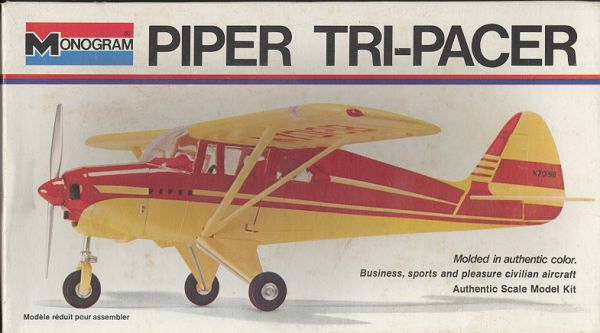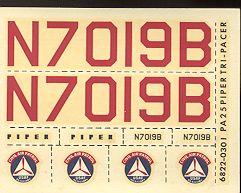
|
KIT: |
Monogram Piper Tripacer |
|
KIT # |
6822 |
|
PRICE: |
$ |
|
DECALS: |
One aircaft |
|
REVIEWER: |
|
|
NOTES: |
Long OOP, 1973 boxing |

|
HISTORY |
Shortly after WWII, Piper was going great guns in the light plane market. They were affordable and inexpensive to operate and the various versions of the Cub and Super Cub were selling like hot-cakes to many new pilots. Piper then decided to take things a step farther for those who wanted to upgrade to the next level of light aircraft and so developed the Pacer. This was also a tail-dragger like the Cub and Super Cub but boasted increased performance from its Lycoming engine that was in with the Super Cub. Unlike the previous aircraft, it offered seating for more than two people.
Adding to the semi-success of the Pacer, Piper basically turned around the main landing gear and added a nose wheel. Nose wheel aircraft are much easier to operate from prepared strips and offer the pilot greater vision while on the ground and during initial take-off phase before the tail wheel comes up. It also makes it much easier to land as one could come in nose high without worrying about having the tail wheel hit first.
In terms of ease of flying, it was just as easy as the previous types and with 173 hp from its engine instead of the 50 or 60 that were in the Cub, it was much more controllable in different flight regimes. By the standards of the day, it was also luxurious, having an interior that rivaled most automobiles with comfortable seats, radios and even ash trays. The interiors were even color coordinated with the exterior paint trims.
Reader Glen Galer adds this information: "The Shortwing Pipers grew out of an economy series beginning in 1948 with the PA15/PA17 series Vagabond. Piper cut the wingspan of the Cub by 6' to reduce cost (just 29' 3", thus the nickname "Shortwing Pipers"). The Vag's were two-place side-by-side, replacing the late 30's/early 40's J4 & J5, Cub-based planes. 384 Vag's were built. From this came the PA16 Clipper, which was the first four-place Piper, 736 built in 1949, until Pan Am sued over the name Clipper. The Vag and the Clipper had control sticks, 65hp & 115hp Lycomings respectively, and no flaps. From Jan 1950 to Sep 1954 the PA20 Pacer was sold, with flaps, 125/135hp Lycomings, control wheels and a higher level of mechanical sophistication and "luxury" than the predecessors. From Dec 1950 to Aug 1960, 7629 PA22 Tri-Pacers were built with 125, 135, 150 and 160hp Lyc's. They had all the goodies of the Pacer, plus the tricycle gear, and ultimately more power, features, higher service ceiling, etc. In late 1960 the four-place series was put to rest with the introduction of the PA28 Cherokee, designed by Fred Weick of Ercoupe fame. However, Piper continued production of the PA22-108 (hp) Colt, a two-seat trainer of which 1849 were built from 1960-1964. They had yokes but no flaps. When the Cessna 150 & 152 came on the scene, the tube and fabric Pipers met their end. Piper tried for a modern, aluminum trainer with the Tomahawk (sometimes referred to as the Trauma-Hawk!) with little success."
|
THE KIT |

Monogram's kit dates back to the 50's and is very typical of the age with opening doors and a displayable engine. I have notes that state it is 1/48 scale, however it seems larger than that judging from the figures. Molded in a rather garish yellow plastic (to make it easier to paint, no doubt), the kit boasts raised detail that is very well done. The kit is also remarkably flash free, though this is the 1973 boxing and not the original 1956 one. It is just about as complete as you could want though light planes are not usually detail intensive anyway.
 Instructions are the picture type
with many construction steps. Painting information is given in each of those
steps. Probably the most difficult job will be masking this one if you choose to
emulate the scheme on the box top. Only registration numbers, Piper logo and CAP
logo are provided on the old and somewhat yellowed decal sheet. That means a lot
of masking tape will be needed for the red on the fuselage.
Instructions are the picture type
with many construction steps. Painting information is given in each of those
steps. Probably the most difficult job will be masking this one if you choose to
emulate the scheme on the box top. Only registration numbers, Piper logo and CAP
logo are provided on the old and somewhat yellowed decal sheet. That means a lot
of masking tape will be needed for the red on the fuselage.
Despite the fact that this kit has been around for decades I've never seen one built, and that includes the one I started when I was a kid. I think it fell victim to hidden enemy sabotage sometime after the airframe was basically complete. The scale equivalent of several pounds of TNT (i.e. firecrackers) were placed in it and it was blown smithereens during a test flight. Fortunately no one was harmed but the Tripacer was never the same again.
|
CONCLUSIONS |
For we baby-boomers this is a kit from our youth. For others it
is just another old kit, but one which should be relatively easy to build and
should look great when you get it properly painted. Kit courtesy of my kit collection. If you would like your product reviewed fairly and quickly by a
site that has well over 100,000 visitors a month, please contact
me or see other details in the Note to
Contributors.